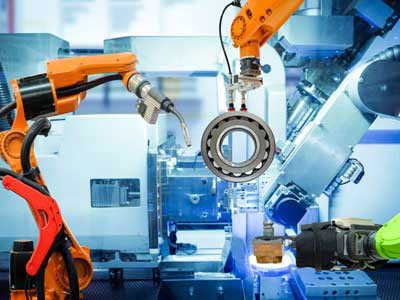Key Takeaway
Industrial robots come in five main types: articulated, SCARA, delta, cartesian, and collaborative.
Articulated robots have rotary joints and are flexible, ideal for complex tasks like welding. SCARA robots are good for pick-and-place tasks due to their horizontal alignment. Delta robots, with their spider-like arms, are perfect for high-speed sorting and packaging. Cartesian robots move in straight lines and are used for 3D printing and CNC machines. Collaborative robots, or cobots, work alongside humans safely, assisting in tasks like assembly. Each type of robot has unique strengths, making them suitable for different industrial applications.
Articulated Robots
Articulated robots, resembling a human arm with joints and links, are versatile workhorses in manufacturing. With their multi-jointed structure, these robots excel in tasks requiring flexibility and precision, such as welding, assembly, and material handling. Their ability to reach around obstacles makes them ideal for complex production lines where dexterity and agility are paramount. Additionally, articulated robots can adapt to various tasks by changing end-effectors, enhancing their utility in diverse industrial applications. This adaptability and precision contribute significantly to improving production efficiency and maintaining high-quality standards.

SCARA Robots
SCARA (Selective Compliance Assembly Robot Arm) robots are widely recognized for their efficiency and precision in industrial automation. These robots are structured with a horizontal shoulder, elbow, and vertical wrist joint configuration, allowing them to excel in repetitive tasks such as assembly, picking, placing, and packaging within manufacturing environments. Their rigid design ensures high repeatability, making them indispensable in industries that rely on fast-paced and accurate production lines.
SCARA robots are particularly favored in automotive assembly lines, electronics manufacturing, and consumer goods production. Their ability to swiftly execute tasks with minimal deviation in movement paths contributes to increased productivity and consistency in output. Engineers often integrate SCARA robots into processes where speed and precision are critical, leveraging their capabilities to streamline operations and enhance overall efficiency.
These robots are equipped to handle payloads ranging from light electronic components to heavier items like automotive parts, adapting flexibly to various manufacturing requirements. Their application extends to tasks such as screw driving, soldering, and inspection, where their precise movements and positional accuracy ensure optimal results. In essence, SCARA robots embody reliability and performance, embodying the evolution of robotic technology in industrial applications.
Delta Robots
Delta robots represent a pinnacle of engineering ingenuity in the realm of high-speed and agile automation. Known for their distinctive parallel linkage design and lightweight construction, these robots are specifically engineered for rapid picking, sorting, and packaging tasks in industries such as food processing, electronics, and pharmaceuticals. Their ability to maneuver swiftly within confined spaces while maintaining exceptional precision makes them indispensable in operations that demand swift cycle times and delicate handling.
Engineers favor Delta robots for applications where speed and flexibility are paramount, leveraging their capabilities to optimize production throughput and operational efficiency. These robots utilize a parallel mechanism that minimizes inertia, allowing for rapid acceleration and deceleration during tasks such as sorting items on conveyor belts or packaging delicate items in pharmaceutical production lines.
In industries where hygiene and cleanliness are critical, such as food and pharmaceutical sectors, Delta robots are preferred for their ability to meet stringent regulatory standards while ensuring consistent product quality. Their versatility extends to tasks requiring intricate movements, such as placing toppings on pizzas or assembling miniature electronic components, where their precise control over movement paths ensures minimal product waste and maximum yield.
Cartesian Robots
Cartesian robots, commonly known as gantry robots, are pivotal in industrial automation due to their robust structure and precise movement capabilities across three linear axes: X, Y, and Z. These robots excel in tasks demanding heavy-duty handling, such as palletizing, CNC machine tending, and large-scale material handling in industries spanning automotive assembly lines to logistics warehouses.
Their box-like design provides exceptional stability and rigidity, ensuring high accuracy in repetitive tasks. Cartesian robots are prized for their ability to cover expansive work areas efficiently, optimizing production processes by reducing cycle times and enhancing overall productivity. This makes them indispensable in environments where reliability and precision are paramount.
Collaborative Robots (Cobots)
Collaborative robots, or cobots, mark a significant evolution in industrial robotics by facilitating safe and seamless interaction between humans and machines on factory floors. Unlike traditional robots that operate in isolation, cobots are designed with advanced sensors and safety features to work alongside human operators effectively.
These robots are equipped to perform a wide range of tasks, from assembly and quality inspection in manufacturing settings to delicate procedures in healthcare, such as surgical assistance. Cobots prioritize safety, employing sensors that detect human presence to ensure immediate reaction to avoid accidents. This capability not only enhances workplace safety but also improves operational flexibility and efficiency.
Cobots are transforming industries by streamlining workflows and adapting swiftly to changing production needs. Their user-friendly interfaces and collaborative nature empower workers, augmenting productivity while maintaining a high standard of safety. As industries embrace automation, cobots emerge as pivotal tools in achieving operational excellence and meeting the demands of modern manufacturing environments.
Conclusion
Industrial robots vary widely, each designed for specific needs. Articulated robots offer flexibility, SCARA and Delta robots provide speed, Cartesian robots deliver precision, and cobots ensure collaboration. Understanding these types enhances manufacturing efficiency and innovation. By knowing the roles of articulated, SCARA, Delta, Cartesian, and collaborative robots, you can better navigate and optimize automation processes in diverse industrial applications.
